A travel blog
Journeys around India, travels around the world, people and places
Friday, November 2, 2018
Monday, May 20, 2013
Flamingos in Singara Chennai
I made a quick trip to Chennai aka Madras last month on the inaugural run of the double decker train between Chennai and Bangalore and here is what I found. On a dull morning, we saw several flamingos in the marshes of Pallikarnai. This is a first for me as I have not seen flamingos before in Madras.







Labels:
bird watching,
birding,
Birds,
chennai,
madras
Friday, May 10, 2013
Skywatch this Friday..a dawn in Srinagar, Kashmir
Rains and thunderstorm the greeted us the afternoon we reached Srinagar, Kashmir. And this is what the morning after looked like on Nagin Lake � but there is a beauty in the mist, the gloom, the darkness and the sun fading away in the waters
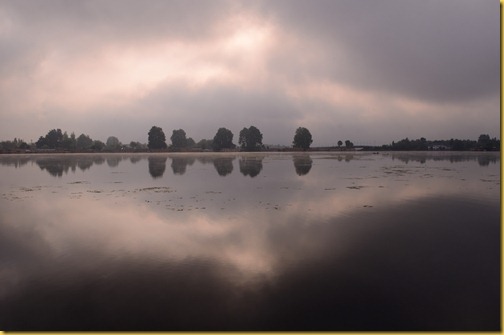
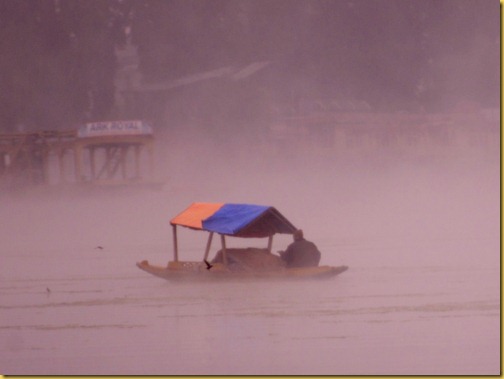
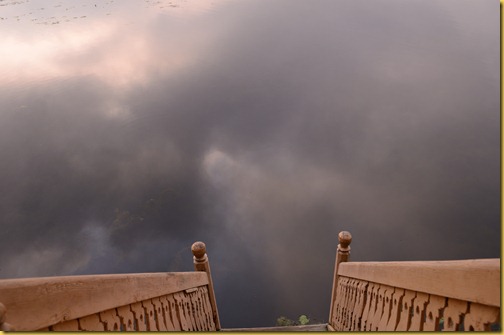

To see more gorgeous skies around the world , do visit Skywatch




To see more gorgeous skies around the world , do visit Skywatch
Labels:
Jammu and Kashmir,
Kashmir,
Skywatch,
Srinagar
Wednesday, May 8, 2013
Avila�a fortified town in Spain

It is the early afternoon. I am standing in front of a little shrine called Los Cuatro Postes or The Four Posts where four pillars encloses a cross. I climb up a short flight of steps and look out into the vast open space from the shrine. In the immediate distance lies an entire town enclosed by massive granite walls. Towering and formidable, these walls rise above the ground to touch the dark gloomy sky pregnant with droplets of rain. Tinged with a shade of brown ochre, the walls are intact and they look aesthetic as their flat surfaces are interrupted by a series of semi-circular turrets, adding a geometric pattern to them. Standing tall at 12 metres, these brown walls are punctuated with nine gates built across the length of 2.5 kms, with 88 towers that give the city its stony look.
It feels a bit mysterious to live in a town that is almost completely surrounded by these stone walls. I shiver a bit in the cold, lost in a land that seems to be out of a fairy tale, dwarfed by these imposing structures. But there is a beauty in the barrenness. As I am admiring the view, a newly married couple lock lips and pose for a wedding portrait against the backdrop of the town
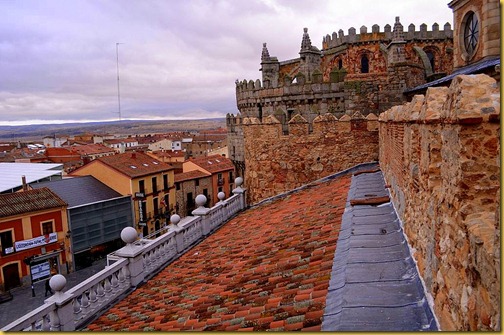
Ringed in by the Sierra Gredos mountains, Avila is a Roman town perched on a rocky outcrop on the banks of the Adija River in Spain. Often referred to as the land of saints and stones with the Gothic and Romanesque churches dotting its landscape, Avila is a UNESCO World Heritage City that looks lost in a dreamy stupor of the past. The walls, built in the Middle Ages are virtually the symbol of the town, visible from almost any part of Avila
Avila however has had a war torn history prior to the construction of its impregnable walls. It was the home of the Celtic tribes known as �Vettones� around the 5th-7th centuries BC and was called the Obila or the High Mountain then. The Romans invaded it around the 1st century AD and called it Abila and ruled for almost six centuries.
However it became a war zone during the Middle Ages between the 7th � 11th centuries with frequent wars between the Islamic Moors and the Christian kingdoms leading to Avila becoming a ghost town eventually. Avila was finally repopulated under the reign of Raymond of Burgundy in the 11th century who ordered the construction of these walls to protect it from further attacks .Ever since they have remained as a strong formidable presence in the town, keeping all invaders at bay.
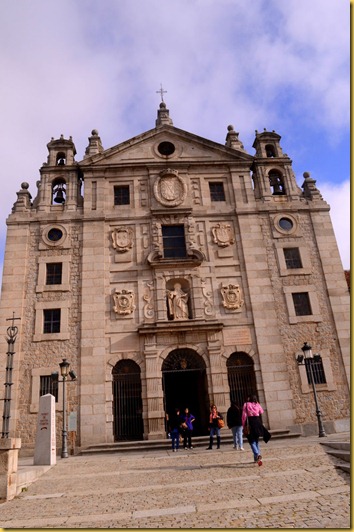
However Avila has a mystical side as well. It was home to several saints, including St Theresa of Jesus, the 16th century patron saint of Avila who had reformed the Carmelite Order across Spain. And my guide, Blanca shares a little anecdote from her life that took place at The Four Postes. St Theresa �s childhood was rather dramatic. She had visions of Christ besides being tormented by The Devil. When she was barely seven , she was planning to run away with her brother and fight for her state against the Moors. It is believed that her uncle stopped her right here at the Four Posts, just as she was planning her escape . St Theresa however grew up to become a reformist and started spreading her faith, not just in Avila but across Spain as well.
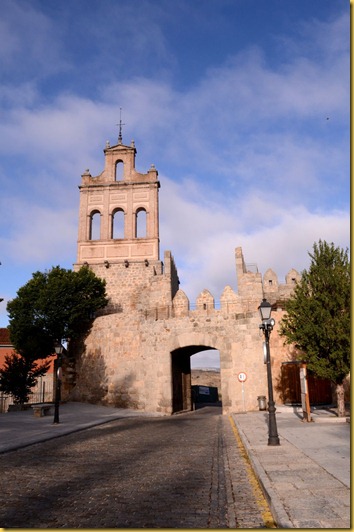
I start with a journey up the walls. There are several routes and I begin at the Puerta Del Carmen , or the Gate of El Carmen, that takes its name from a Carmelite convent attached to the walls . I walk right atop the wall, along the entire length, only to see them stretching endlessly for miles.. The town now wears a fresh coat of paint as Avila shows me her true colours. Huddled below are several pink, white and red houses looking petite as the walls wrap them in their folds. As we look down the sloping roof while palaces and cathedrals dot the landscape, my guide , Blanca shows me some stone sculptures of bulls or boars carved on the surface of the walls that date back to a period before the Romans arrived. Standing there, I am lost in my thoughts, with the wind blowing right into my face. I imagine it during the medieval era when knights guarded their fortresses and horse hoofs trotted in the distance.
I am back on the cobbled streets that take me into palaces, monasteries, chapels and churches. I stop by at The Cathedral of Avila, built between the 11th-12th centuries in the Gothic style of architecture, around the same time when the city was fortified. Built with granite, it is looks like a fortress with its apse shaped like a turret as it forms a part of the city walls, probably reflecting the history of the era where battles were raged constantly.
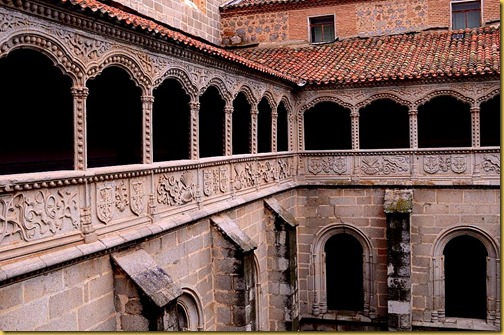
Another monument that draws me is the Santo Thomas Royal Monastery, built in the 15th century in a Gothic style. With three elegant cloisters, built across two storeys, the monastery holds the tomb of Prince Don Juan, the crown prince of King Ferdinand and Queen Isabella, who are best known for sponsoring Christopher Columbus� voyage . While the marble crypt remains, the guide tells us that tomb is empty as his remains were desecrated during one of the wars.
Our next stop is a small shrine that Avila is proud of. The sky gets gloomy again, but in that grey atmosphere, a colourful toy train chugs along bringing in a group of tourists through one of the many city gates. The train, taking the tourists through the nine gates of Avila finally stops in front of a 17th century convent, which was once the home of St Theresa, the saint and writer who travelled from Avila to all over Spain reforming the Carmelite Order. Built after her canonisation, the convent is closed to the public, but tourists can visit the chapel located inside the Baroque church.

We walk in to see her relics and amidst the rosary and other personal effects, is a fragile finger with a ring is placed there as well. It is believed to be her finger from the right hand. But it is not just the relics. The silence in the chapel draws me like a magnet as I sit there for a while inside a reconstructed version of a cell where she prayed.
I move on to a livelier part of Avila. The city square is vibrant and is thronged with tourists. Avila�s proximity to Madrid (it takes barely a couple of hours by road) and its World Heritage status seems to draw a lot of them here. Little surprises spring on me as I wander around aimlessly. A South American, from Argentina wearing a bright colourful costume plays a guitar and entertains the locals. In the square a young choir group is in the midst of an energetic performance of hymns. Elsewhere a little bit of India is tucked away in a small souvenir shop called The Taj Mahal.
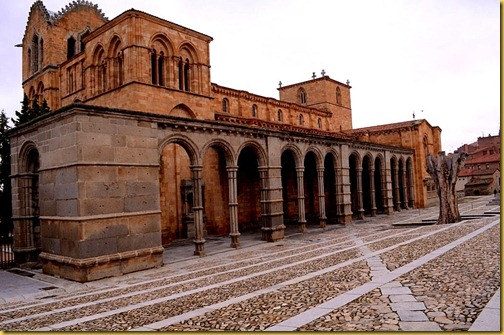
It is almost dusk and darkness descends on Avila within minutes, even as the city glows in a spectacular display of lights as the walls and the monuments are lit. I walk along the tiny cobbled lanes running into statues of saints. Bells greet me in every corner. I shiver in the cold as the stars come out into the sky. It is a surreal moment. The outlines of the walls stand out reassuringly against the dark sky, as silence wraps the ancient town in a thick blanket. Every lane leads to a little piece of history. Legends are written in small sculptures that are tucked away in the corners. And St Theresa greets me everywhere � on names of squares and streets.
My last stop at Avila is a quaint sweet shop that serves the traditional sweet made of egg yolk that goes by the name of �Yemas de Santa Theresa� . As I bite into the juicy piece of dessert, I see more sweet shops on the way and the road finally leads me back to the walls .
A version of this story was published in HT Mint.
Monday, April 22, 2013
Trekking through India's Golden Triangle
Plan an Unforgettable Trek Through India�s Golden Triangle
There's nothing like the Golden Triangle. Comprised of several Indian destinations, this must-try trek is one of the best ways to experience the country's most iconic sights. Though a variety of travel agents and tour providers offer packages, it�s completely possible to plan your own tour with a little bit of know-how and a lot of adventurous spirit. Plus, if you have an AmEx credit card, you�ll get benefits for cardmembers that make the planning process even easier.
Ready to get started? Use this sample itinerary for a few travel ideas.
Delhi
Begin your trip in this cultural center for an inside look at the area�s rich history. If you want to get a feel for the local lifestyle before trekking toward the historical sites, grab a quick kathi lunch at Khan Chacha, and then browse the Khan Market for local music, home goods and accessories. Finish your first day with a cocktail at Cheri, or get into the local speakeasy scene at Cocktails & Dreams.
Wake up early the next day to get a head start on exploring Delhi�s icons. Browse through India Gate and the Rashtrapati Bhaven, and then make your way to Old Delhi to brave the 17th-century streets of Shahjahanabad. Still have some energy left? Browse the Khari Baoli spice market, and pay a visit to the Shah Jehan-designed Red Fort.
Agra
Of course, no Golden Triangle trek would be complete without a trip to Agra. You�ll want to spend most of your time exploring the magnificent Taj Mahal, but save a few hours � or an entire day � for adjacent sights like the Mehtab Bagh gardens, the Kailash and Rajeshwar temples and the bustling U.P. Handicraft & Handloom Center.
Hungry for an authentic taste of Agra? Unwind at the Kamat Hotel�s rooftop restaurant or settle in for a cocktail at the Terrace Grill. Don�t forget to bring your credit card; you might just get some benefits for cardmembers that let you earn points on these experiences.
Jaipur
If you�re short on time and can�t spend weeks exploring Ranthambhore, Udaipur and Jodhpur, the best place to end your Golden Triangle circuit is in the thriving city of Jaipur. Known as the Pink City, this historic destination is famous for its forts, temples and sandstone buildings. Spend the first few hours getting acclimated to the area by exploring the Bapu and Johari bazaars, and then pop into Rawat Misthan Bhandar for a taste of the iconic pyaz ki kachori onion dish. Have a little extra time? Stop here, and head back to the hotel to relax before your last full day of sightseeing.
Once you�re ready to take in the sights, start just north of town at the Amber Fort to get a look at this fortress-palace and some unforgettable views of the surrounding gorge. Then, come back to the city center to wander through the intricately decorated Hawa Mahal and the 17th-century Jai Singh Observatory. Finally, bid farewell to the Golden Triangle with a self-guided tour of the majestic City Palace, and then drive back to Delhi for one last overnight stay. The trip may be over, but the memories will last forever.
This is a sponsored post.
Ready to get started? Use this sample itinerary for a few travel ideas.
Delhi
Begin your trip in this cultural center for an inside look at the area�s rich history. If you want to get a feel for the local lifestyle before trekking toward the historical sites, grab a quick kathi lunch at Khan Chacha, and then browse the Khan Market for local music, home goods and accessories. Finish your first day with a cocktail at Cheri, or get into the local speakeasy scene at Cocktails & Dreams.
Wake up early the next day to get a head start on exploring Delhi�s icons. Browse through India Gate and the Rashtrapati Bhaven, and then make your way to Old Delhi to brave the 17th-century streets of Shahjahanabad. Still have some energy left? Browse the Khari Baoli spice market, and pay a visit to the Shah Jehan-designed Red Fort.
Agra
Of course, no Golden Triangle trek would be complete without a trip to Agra. You�ll want to spend most of your time exploring the magnificent Taj Mahal, but save a few hours � or an entire day � for adjacent sights like the Mehtab Bagh gardens, the Kailash and Rajeshwar temples and the bustling U.P. Handicraft & Handloom Center.
Hungry for an authentic taste of Agra? Unwind at the Kamat Hotel�s rooftop restaurant or settle in for a cocktail at the Terrace Grill. Don�t forget to bring your credit card; you might just get some benefits for cardmembers that let you earn points on these experiences.
Jaipur
If you�re short on time and can�t spend weeks exploring Ranthambhore, Udaipur and Jodhpur, the best place to end your Golden Triangle circuit is in the thriving city of Jaipur. Known as the Pink City, this historic destination is famous for its forts, temples and sandstone buildings. Spend the first few hours getting acclimated to the area by exploring the Bapu and Johari bazaars, and then pop into Rawat Misthan Bhandar for a taste of the iconic pyaz ki kachori onion dish. Have a little extra time? Stop here, and head back to the hotel to relax before your last full day of sightseeing.
Once you�re ready to take in the sights, start just north of town at the Amber Fort to get a look at this fortress-palace and some unforgettable views of the surrounding gorge. Then, come back to the city center to wander through the intricately decorated Hawa Mahal and the 17th-century Jai Singh Observatory. Finally, bid farewell to the Golden Triangle with a self-guided tour of the majestic City Palace, and then drive back to Delhi for one last overnight stay. The trip may be over, but the memories will last forever.
This is a sponsored post.
Friday, April 19, 2013
Birding Diaries�Carambolim Lake, Goa

Lesser whistling ducks

It�s a very hot morning in Goa. They say spring is in the air, but I can feel the bright sun burning through the skin as early as 630 am. However, I am an early bird and that in Goa is rather unusual. As I head out, all I see in my fifteen minute journey are two pups cuddled up in the middle of the road. The vada pav stalls are not yet open and I do not see a single local tea shop on the road. Soon civilisation gives way to large tracts of fields and then the waters fill my eyes. The Mandovi gives me company as I watch a few waders on her banks while a couple of pond egrets fly rather low. Even the fishermen have given themselves a holiday and the roads are empty.
I am not headed to a beach but to a little lake lost amidst the lone tracks of a railway station in a little hamlet. Carambolim or Karamali is a pretty village tucked away in old Goa. Its claim to fame is a railway station, a 500 year old chapel and a Brahma temple located close by. But none of them lure me.
Carambolim is still snoozing when I drive past its nondescript streets. Taking in the silence and the pleasant morning breeze, we stop by for a few minutes to cross a railway track. A lone train chugs along, taking passengers to either their dream destinations or to a comfort zone called home. The train slows past me and I cross over to a single lane that takes me into a palette of colours. There are the verdant fields on one side, nodding in glee to the morning breeze and a vast man -made lake on the other bustling with active bird life.
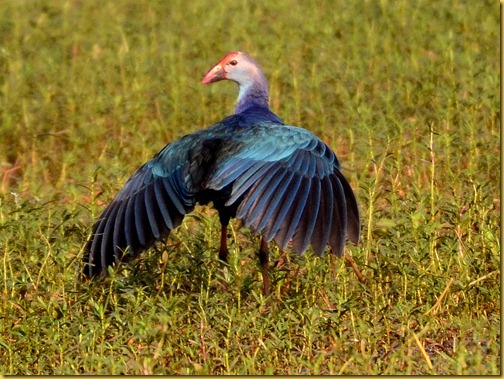
Standing under the shade of the tree, I see the train has paused in its journey, its blue compartments reflecting in the waters of the lake. Another train seems to approach from the other end and they pause for a moment as strangers glance at each other from either train before continuing with their journeys.
A flock of lesser whistling ducks announce their presence whistling out loudly as they frolic in the waters for a while, splashing before settling down. They are huge in numbers compared to the flock of garganeys that float quietly. I look at them through the binoculars as they curl up in the waters. The purple swamp hens strike several poses as they create a stark contrast in the marshland . An open stork bill stands quietly, getting a bit of tan, while the two jacanas � the bronze winged and the pheasant tailed are rather shy, the latter especially showing off its long curved tail before disappearing into the waters. A purple heron is in flight and lands near the flock of lesser whistling ducks. Coots and grebes lose themselves in the crowd.

We head to the other bank of the lake and who should be waiting there, but a bright glossy ibis, preening itself in the sun. A darter darts past while a grey heron stands as a statue. Puddles of water stand out in the green marshland as heads of ducks pop out of them. They fly across the lake, crossing from one side to another, whistling along .
I stand there for hours, forgetting the heat and hunger, longing for more time in the company of birds. The silence stands out as the birds call out in glee. I wonder how this little idyllic world is lost on man. That�s when I realize why Goa is not just a destination � it�s a state of mind.
Friday, April 12, 2013
Skywatch this Friday � Pelicans in flight
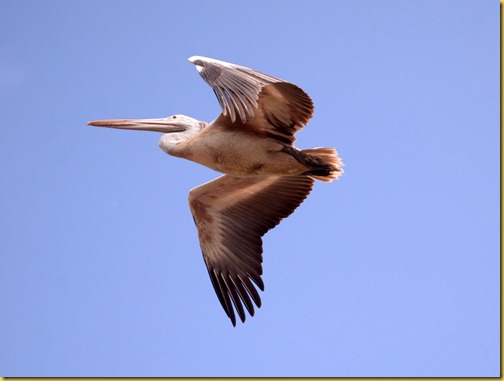
A spot billed pelican in flight at Kokkre Belur, a village near Bangalore, India where the birds have forged a relationship with the community that protects them every year. Another close up of the wings

Visit Skywatch this Friday for beautiful birds and skies.
Subscribe to:
Posts (Atom)